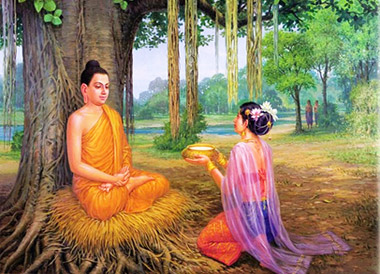- Home
- Buddha
- About Us
- Thrangu
- Nun Temple
- Princess Wencheng Temple
- News
- Teachings
- Tibetan
- Foundation
- Sharing
- Offering
Shakyamuni Buddha(4)The Practice of Austerities
Date:2018-09-29 Clicks:
Shakyamuni Buddha
The Practice of Austerities
 At this point in time, a tradition of meditative practice was already flourishing in northern India, and Siddhārtha proceeded to learn what he could from the foremost teachers of the day. He quickly mastered the meditative practices they taught, only to discover that although such techniques resulted in states of meditative bliss, they did not bring about liberation from suffering. Determined to persist until he discovered the means to completely eradicate all suffering, Siddhārtha moved on, next experimenting with the numerous ascetic practices also found at that time in India. To that end, he engaged in the severest of physical austerities in the company of five like-minded companions near the Nairañjanā River in central India. Later in life, the Buddha would describe his physical condition during this period of intense asceticism to his disciples as follows: When his hand passed over his body, the Buddha said, his body hairs fell out at the touch, having rotted to their roots. If he touched his stomach, he told them, he could feel his backbone, and if he stood up to stretch, he promptly fell flat on his face. After six years of austerity, Siddhārtha realized that his physical weakness had become an impediment, and not a means, to spiritual progress. Recognizing that such practices could not bring him the lasting happiness of enlightenment, he decided to resume eating to nourish his body. Doing so, he soon began to regain strength, but lost the respect of his five companions, who scorned him as a weak-willed hedonist.
At this point in time, a tradition of meditative practice was already flourishing in northern India, and Siddhārtha proceeded to learn what he could from the foremost teachers of the day. He quickly mastered the meditative practices they taught, only to discover that although such techniques resulted in states of meditative bliss, they did not bring about liberation from suffering. Determined to persist until he discovered the means to completely eradicate all suffering, Siddhārtha moved on, next experimenting with the numerous ascetic practices also found at that time in India. To that end, he engaged in the severest of physical austerities in the company of five like-minded companions near the Nairañjanā River in central India. Later in life, the Buddha would describe his physical condition during this period of intense asceticism to his disciples as follows: When his hand passed over his body, the Buddha said, his body hairs fell out at the touch, having rotted to their roots. If he touched his stomach, he told them, he could feel his backbone, and if he stood up to stretch, he promptly fell flat on his face. After six years of austerity, Siddhārtha realized that his physical weakness had become an impediment, and not a means, to spiritual progress. Recognizing that such practices could not bring him the lasting happiness of enlightenment, he decided to resume eating to nourish his body. Doing so, he soon began to regain strength, but lost the respect of his five companions, who scorned him as a weak-willed hedonist.
This article is extracted or downloaded from https://www.kagyu.org
